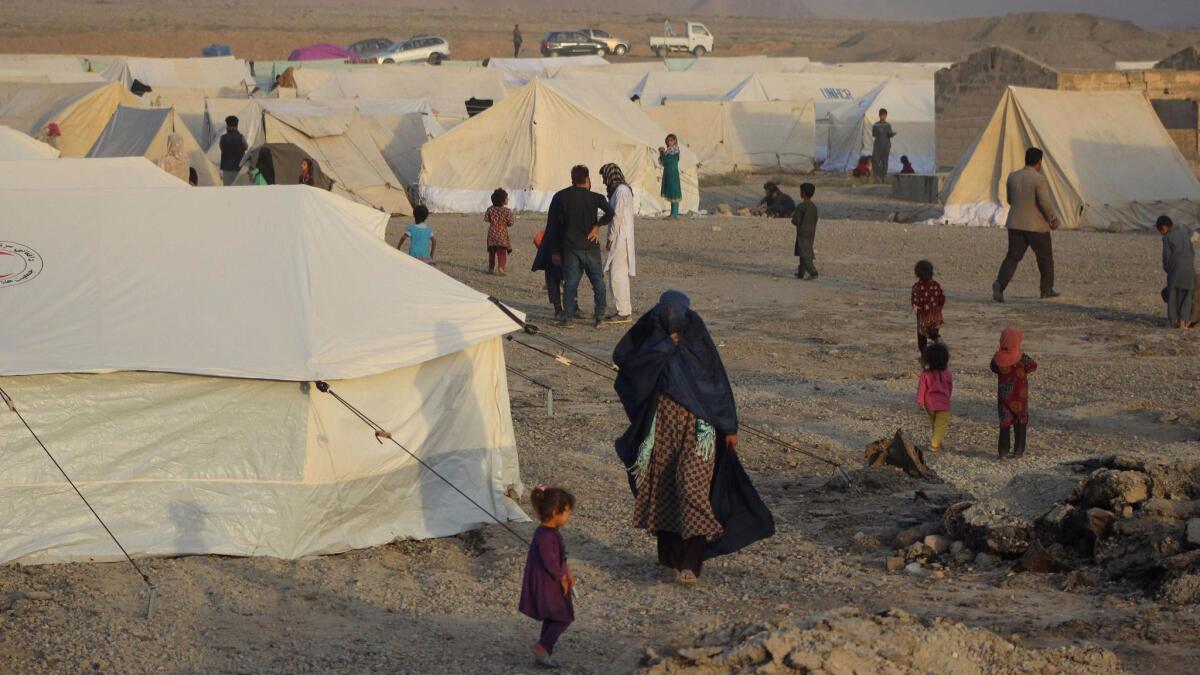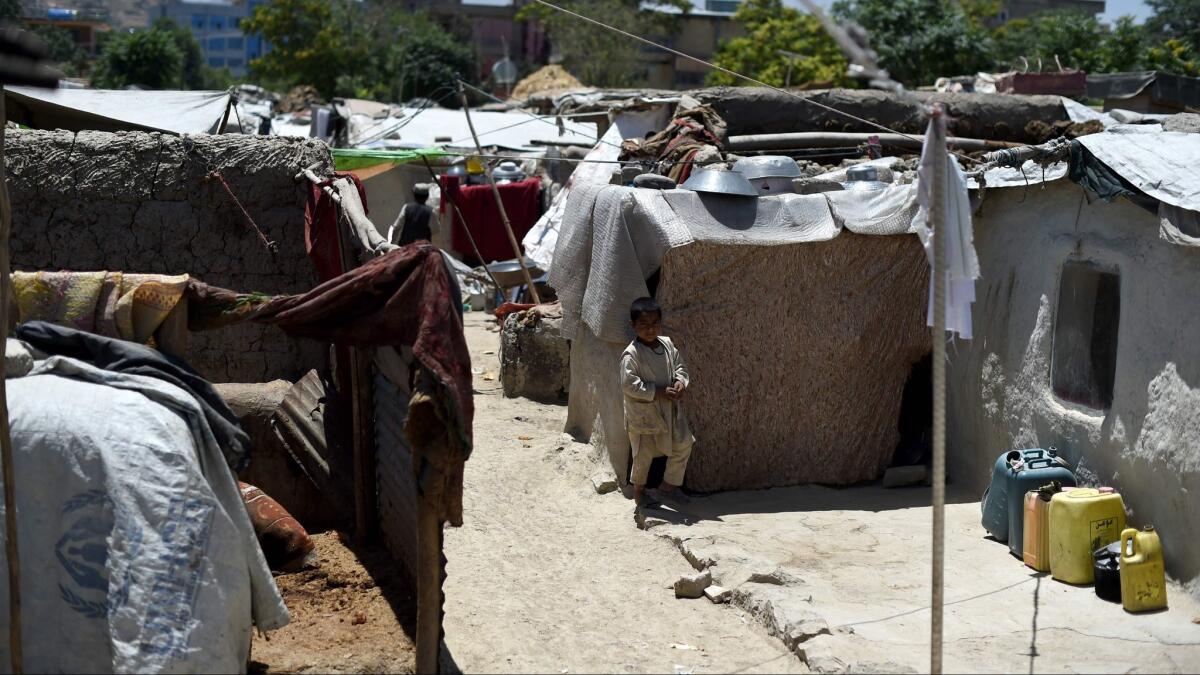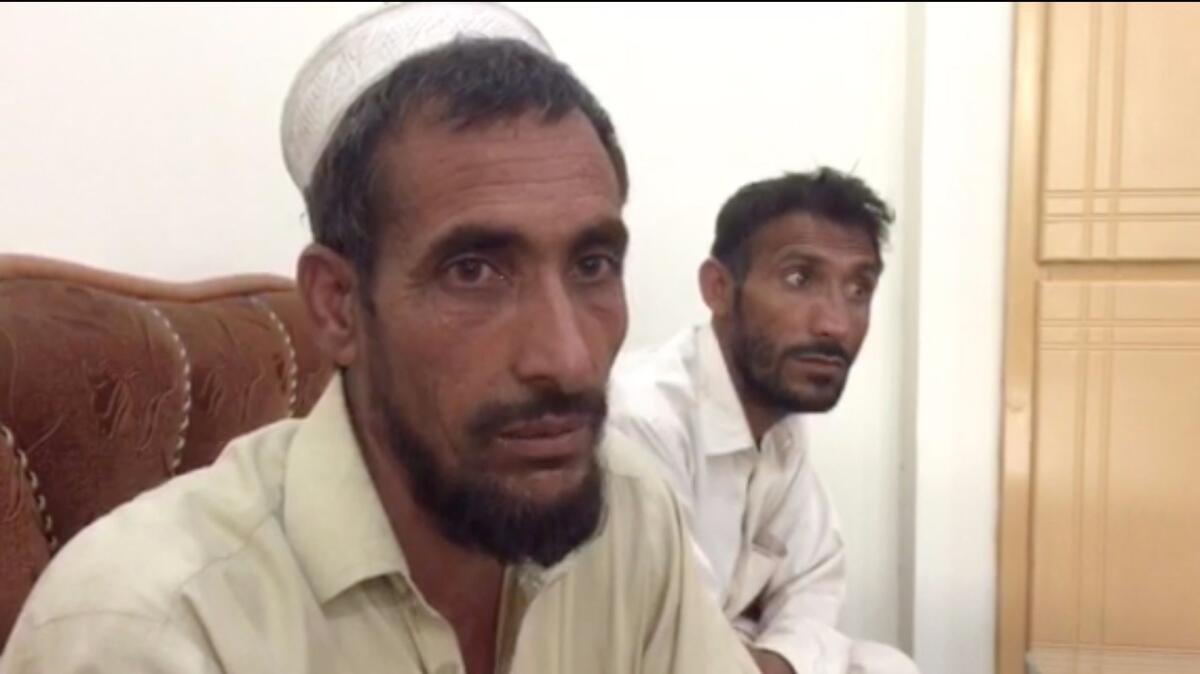The increasingly popular way to aid the needy in war-torn nations: Give cash

A makeshift camp in Takhar province for Afghans displaced by ongoing fighting against Taliban militants.
- Share via
Reporting from Jalalabad, Afghanistan — Donations of food, tents and blankets have always been a staple of international aid, the feel-good solution that everyone could take part in to help stem the tide of international misery.
But for years, the lesser-known story of those donations has been how often they fail to help. After the 2004 tsunami in Southeast Asia, predominately Muslim communities in Indonesia received cans of pork. Goose-down ski jackets went to Sri Lanka, known for its tropical climate and monsoons. Donated tents and cooking utensils can often been seen in market stalls in Afghanistan.
With the help of new technology, a different model is rapidly gaining currency around the world for providing victims of war and natural disaster with what they need most: money.
Several of the United Nations’ most high-profile aid programs, including the World Food Program, Children’s Fund and the High Commissioner for Refugees, have all launched programs to deliver aid in cash. Private charities including CARE, Oxfam and the International Rescue Committee have launched similar projects.
The trend had its genesis in the mid-1980s when UNHCR was among the first agencies to use cash-based interventions, mainly for those voluntarily returning to their homes after displacement.
Today, UNHCR is focused on expanding cash aid “as a matter of priority” in more than 60 countries to help with a variety of needs, including shelter, education and income support, according to Jenifer Fenton, a spokeswoman for the agency.
“Cash-based initiatives allow refugees and others of concern to prioritize their needs, giving them more control over their spending, in turn allowing them to live with greater dignity,” Fenton said in a statement.
She said UNHCR plans to have cash assistance in place for most of its humanitarian assistance operations by 2020.
CARE has been gradually increasing its cash payments for both relief and development work, using such methods as vouchers, cash for work, conditional cash transfers and cash grants, said Lex Kassenberg, the group’s emergency response director. Cash assistance has been essential in helping with the Syrian refugee crisis in Iraq, Lebanon, Jordan and Turkey, Kassenberg said.
But cash aid still represents just 6% of assistance across the humanitarian aid sector. And reluctance to use it persists.
Critics worry that the money — in most cases given without conditions — will be misused and spent on non-life-sustaining goods, including weapons. Recipients may become dependent on handouts. There are also concerns that cash aid could heighten tensions between displaced people and host communities who might also be needy but ineligible for such grants.
“There is an accountability angle to cash assistance, where the implementing agencies can only account for the amount of money provided to the beneficiaries, but not for what the beneficiaries do with this money,” said Kassenberg. “This is probably one of the reasons why donors in the past have been reluctant to fully embrace this approach.”
Technology is helping aid workers avoid some of the pitfalls and engender trust in the system.
In response to crushing humanitarian need, mounting risks for delivering aid and increasingly inaccessible populations of refugees, the International Rescue Committee is operating a trial program in Afghanistan distributing $1 million in cash through local banks and cellphone providers. The deliveries target tens of thousands of needy people in Helmand and Nangarhar provinces — places at the core of the Taliban insurgency.
The program already is demonstrating the potential usefulness of technology in delivering cash transfers in a country challenged by war and large distances.
Gul Wali and his family are among those now receiving cash assistance under the program.
Wali’s family fled the district of Kot in June after Islamic State militants attacked, killing and kidnapping people, looting and torching homes. Wali was forced to rent a one-room, windowless, mud-walled house for his family here in Jalalabad, eastern Afghanistan.
The rescue committee awarded Wali and his family, who fled with only the clothing they were wearing, a one-time payment of $120 in cash. The former farmer spent most of it on rent and buying some medication and other basic needs.
“Neither the government nor any other organization has helped us so far,” said the 34-year-old father of five, who had owned his own home in Kot. “It’s good to get cash, because I can decide how to spend it.”
Even so, Wali said he was behind on his $20-a-month rent and there wasn’t enough cash left over from the grant to buy food.
The six-month test period for the Afghan project is scheduled to continue through mid-January, but officials said the agency was committed to delivering 25% of its humanitarian assistance in the form of cash relief by 2020, up from approximately 6% in 2015.
David Haines, the IRC’s country director in Kabul, said the organization monitors beneficiaries and finds that needy people usually spend wisely; cash aid, he said, can often help keep a bad situation from getting worse.
“We empower the beneficiaries, we give them the control, we give them the chance to spend that money in the way that most benefits their family,” said Haines. “That might be food, but it might also be life-saving drugs, or their kids might need something important, or it might be for transportation to some place elsewhere in Afghanistan. It enhances their dignity as human beings despite their status as displaced people.”
The IRC has been using mobile phones to deliver payments in Afghanistan, along with the network of hawala dealers who have long been involved in money transfers around the Muslim world.
So far about 2,890 families, in both Helmand and Nangarhar provinces, have received “cash” allocations, said Muhammad Jelani, program coordinator for the International Rescue Committee in Kabul.
Beneficiaries are eligible to receive a one-time payment of at least $105 to help with immediate relief, such as buying household supplies and paying rent, or $75 to $80 via multiple payments over a period of months.
No fees or commissions are charged to the recipients. The rescue committee pays fees to the hawala dealers and cellphone providers.
Hawala dealers are used to distribute actual cash in areas where the banks and communication networks are not able to function — for example, where cellphone towers have been destroyed. The dealers transfer the money to the account of a local agent anywhere in Afghanistan. An IRC staffer then goes with the agent to distribute the cash to identified beneficiaries.
In areas where cellphones are working, funds are transferred electronically and beneficiaries get a text message alert. The beneficiaries can then text the “invisible money” to designated shopkeepers or vendors, who then cash out the money for the beneficiaries to spend in their stores.
This type of system was already being used in Afghanistan, where teachers and police are paid via mobile phone technology. But the method is proving to be particularly useful “when you’ve got people on the move,” said Radha Rajkotia, the IRC’s senior director of economic recovery and development.
“It’s much easier for them to pocket cash, a SIM card or a code,” Rajkotia said. “They can literally keep that in their pocket and keep themselves safe.”


Hakim Khan, who has two wives and 11 children, spent most of the $120 he received from the IRC on rent and medication.
“The IRC support was really good … because the landlord was pushing us to vacate the house,” said Khan, 35, who used to farm wheat and vegetables in the country’s Achin district before fleeing to Jalalabad.
But it’s not just about having a place to live, Khan said. He can’t afford the entry fees to send his children to school.
“Here in Jalalabad city, everything comes with a price, even drinking water,” he said. “I can’t afford to buy gas, so my children go and collect trash to burn instead of gas for cooking.”
While there isn’t yet hard data on whether the cash program is succeeding in Afghanistan, Rajkotia said there are several preliminary positive signs. For example, when women are the beneficiaries they tend to spend the money more evenly across the household on needs such as food and education, Rajkotia said.
“Increasingly, we are going to be forced to question any other interventions against the benchmark of just giving people cash,” she said. “It’s certainly going to shape, and is already shaping, the nature of humanitarian response.”
Special correspondent Faizy reported from Jalalabad and staff writer Simmons reported from Los Angeles.
For more on global development news, see our Global Development Watch page, and follow me @AMSimmons1 on Twitter
UPDATES:
7:28 p.m. Dec. 2: This story has been updated throughout with detail about international programs experimenting with cash assistance.
This story was originally published at 2 p.m. Nov. 14.
More to Read
Sign up for Essential California
The most important California stories and recommendations in your inbox every morning.
You may occasionally receive promotional content from the Los Angeles Times.













